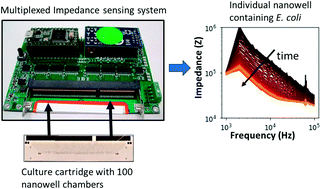Digital electrical impedance analysis for single bacterium sensing and antimicrobial susceptibility testing†
Abstract
Single-molecule and single-cell analysis techniques have opened new opportunities for characterizing and analyzing heterogeneity within biological samples. These detection methods are often referred to as digital assays because the biological sample is partitioned into many small compartments and each compartment contains a discrete number of targets (e.g. cells). Using digital assays, researchers can precisely detect and quantify individual targets, and this capability has made digital techniques the basis for many modern bioanalytical tools (including digital PCR, single cell RNA sequencing, and digital ELISA). However, digital assays are dominated by optical analysis systems that typically utilize microscopy to analyze partitioned samples. The utility of digital assays may be dramatically enhanced by implementing cost-efficient and portable electrical detection capabilities. Herein, we describe a digital electrical impedance sensing platform that enables direct multiplexed measurement of single cell bacterial cells. We outline our solutions to the challenge of multiplexing impedance sensing across many culture compartments and demonstrate the potential for rapidly differentiating antimicrobial resistant versus susceptible strains of bacteria.

- This article is part of the themed collection: Single Cell Analysis


 Please wait while we load your content...
Please wait while we load your content...